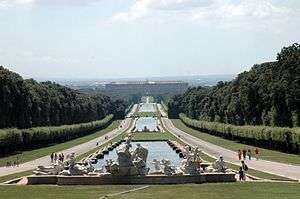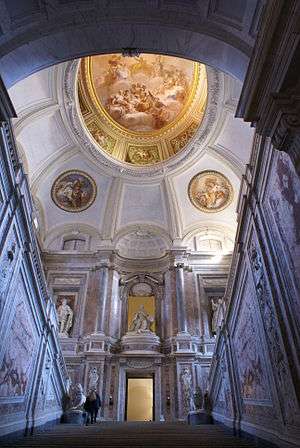Caserta
Caserta is a city in Campania. Its main attraction is the ![]()
Get in
There are regular trains running from and to Naples and Rome coming to the 🌍 train station.
CPTC buses serve Caserta among other bus companies.
Get around
You'll see everyone on a moped, and sometimes 3-5 people on a single one. Driving can be a bit of a nightmare for the faint of heart, as well.
Walking should be fine, like in most places in Italy.
See
Reggia di Caserta


🌍 Palazzo Reale (di Caserta) (Just opposite the train station). Closed on Mondays, Palace: 8:30-19:30 (year round), Garden: 8:30-1.5h before sunset. Arguably the most touristically interesting part of the city. Entrance: €12 including garden, Artecard for 1/2 price.
The palace is one of the largest in Europe, comparable to Versailles, mainly due to the garden architecture - in fact, it was built to compete with it. A former royal residence in Caserta, southern Italy, constructed for the Bourbon kings of Naples. It was the largest palace and one of the largest buildings erected in Europe during the 18th century. In 1997, the Palace was designated a UNESCO World Heritage Site, described in its nomination as "the swan song of the spectacular art of the Baroque, from which it adopted all the features needed to create the illusions of multidirectional space". Interestingly, even the toilet on the ground floor of the palace might be worth a visit.
The 🌍 garden is approx. 3 km long with a few side-branches. A small buffet is available at the north end. There's a (mostly fully occupied) micro-bus service that takes you up and down the garden.
At the north end of gardens, it's possible to enter a separate part - 🌍 Giardino Inglese. It can be entered with the all-in-one ticket, but it closes approx. 1-2h sooner than the rest of the garden. The garden is characterized by the apparent "natural" disorder of plants (many rare), waterways, ponds, "ruins" (resembling Pompeii excavations). Outstanding are the bath of Venus, the Cryptoportico, the ruins of the Doric Temple.
Caserta was used as the location for Queen Amidala's Royal Palace on Naboo in the 1999 film Star Wars Episode I: The Phantom Menace and again in the 2002 film Star Wars Episode II: Attack of the Clones as Queen Jamilla's palace. The same room was also used in Mission: Impossible III as Vatican City. In fact, the square where the Lamborghini is blown up is actually the square inside the Palace. The main staircase is also used in Angels & Demons as the Vatican's staircase. The mezzo soprano Cecilia Bartoli used the palace as primary location for the film "L'art des castrats" that accompanies her album "Sacrificium", dedicated to the music written for the castrato singers of the baroque period.
Do
Buy
Local farmer goods. The artichokes they sell on the side of the road may look suspicious to you, but they're delicious. You can get fresh mozarella, vegetables, and bread daily too. Consider buying some of this for lunch.
Eat
There are plenty of local, family restaurants that are fairly accommodating to foreigners. Look for one that seems nice, and try it. Your mileage will vary, of course, but I generally found people to be friendly.
Drink
Stop into a coffee bar somewhere, and order a cafe. There's a lot of variety, so you may have some trouble ordering one. But it'll definitely be worth it.
Sleep
There are a couple of cheap hotels in via Giuseppe Garibaldi (turn right when you come out of the train station) .
- Hotel Amadeus, via Giuseppe Verdi 72-76 (next to train station and palace), ☎ +39 0823 352663, fax: +39 0823 329195, e-mail: info@hotelamadeuscaserta.it. free wifi from €65 (single), €93 (double).
- Hotel New Baby, ☎ +39 0823 322681, fax: +39 0823 288690, e-mail: info@newbabyhotel.it. Check-out: 11 AM. nice rooms, poor sound insulation, free wifi from €40 (single), €50 (double).
- B&B Caserta Deluxe, Via Unità Italiana 78, ☎ +39 351 523 8866, e-mail: info@casertadeluxe.com. Bed and Breakfast in the center of Caserta. From € 45.
- B&B L'Antico Cortile, Via Tanucci, 55, ☎ +39 3454522070.
- Grand Hotel Vanvitelli, Viale Carlo III, ☎ +39 0823 217111.
- Hotel Europa Caserta, Via Roma, 19 (close to the Reggia royal Palace), ☎ +39 0823 325400.
- Royal Caserta (Jolly Hotel Caserta), V.le Vittorio Veneto, 13 (500 metres away from the Reggia di Caserta), ☎ +39 0823 325222. The hotel offers 107 rooms with a partial view of the panorama of the Reggia.
Connect
Go next
Naples, Rome, and Capri are all close by.
| Routes through Caserta |
| Milan ← Rome ← | N |
→ Naples |
| merges into |
N |
→ Salerno |
| Rome ← | W |
→ Avellino → Brindisi |